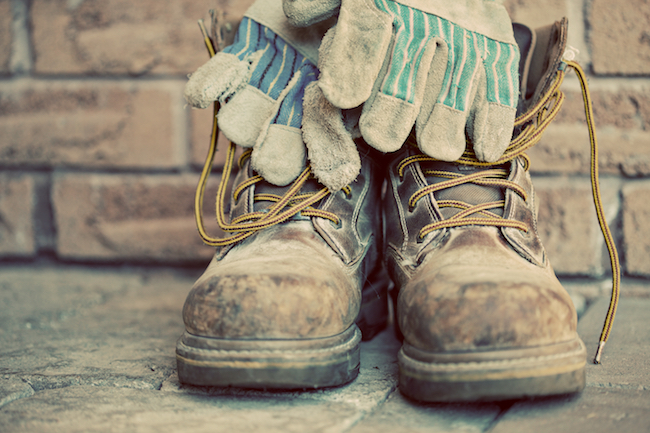
Why PPE built for women means safer working conditions
By Robin Skillings
Improperly fitting or limited protective equipment sends a message that women are not a priority in the skilled trades landscape

Conventional steel toe boots remain a jobsite mainstay, but aren’t always the right choice for all employees. (Getty Images/Michaelmjc)
This commentary was originally published by On-Site, a sister magazine to OHS Canada.
Canada is facing a major skilled trades shortage over the next decade.
While measures are being taken by local and national leaders to attract more workers to the trades, more can be done to recruit from one relatively untapped demographic: women. However, there are many barriers women face when it comes to joining the construction trades, a major one being safety.
Safety is paramount on jobsites, yet many women feel like the personal protective equipment (PPE) available to them is uncomfortable and not made for their sizes or body types.
This can become a major obstacle when it comes to hiring women for work crews and making them feel welcome in the industry.
Keeping every employee safe on the jobsite — regardless of size, shape or gender — is not optional for employers, and in many cases it comes down to finding the right fit.
Demand for skilled tradespeople is expected to remain strong as the economy recovers from the COVID-19 pandemic, government officials and industry leaders say.
Throughout the 2020s, more than 250,000 Canadian construction workers are also expected to retire and replacing these workers will require the recruitment and training of thousands of additional skilled staff. This comes as the federal and provincial governments continue to announce investments in education to both expand and diversify the Canadian skilled trades workforce.
But the question remains: What is being done to outfit these new workers so they are able to safely hit the ground running?
The right PPE is critical
According to the Canadian Centre for Occupational Health and Safety (CCOHS), PPE is the last line of defence for a worker when it is not possible to eliminate workplace hazards, but if the personal protective equipment does not fit properly, it is unable to do its job.
Not only do these items need to meet quality and safety standards in terms of material and design, but a proper fit is crucial to ensuring that PPE can be utilized effectively.
While unisex PPE options are available, they still might not provide a safe or comfortable fit for women.
Providing a wide variety of sizes in both men and women creates a more welcoming atmosphere for incoming workers, recognizing the differences between genders and body types. These efforts can help change the landscape when it comes to workplace culture in the industry by making it more inclusive for all workers.
A 2016 study published in the American Journal of Industrial Medicine found a majority of female construction workers reported fit problems with many types of PPE including gloves, harnesses, safety vests and work boots.
The general criticism was that the equipment was too large or ill-fitting. Equipment designed for men will often not fit women properly, and PPE cannot protect a worker from hazards if it does not fit properly.
Previously, much of the PPE available on the market was designed for men, but simply “shrunk down” to smaller sizes for women.
This forced tradeswomen to become accustomed to needing to know their size across all men’s safety gear, and that included footwear. It also forced women to tolerate a product that was not designed for their anatomy, resulting in poorly fitting gear which ultimately compromised safety.
In a time when inclusivity is so important, improperly fitting or limited PPE not only jeopardizes safety on the jobsite, but also sends a message that women are not a priority in the skilled trades landscape. Consequently, many manufacturers are working to improve this perception through the development of better-fitting and performing PPE for women.
Safety from the ground up
When it comes to PPE, work boots are so much more than footwear and choosing the right boot for the specific job can help to improve overall comfort without sacrificing safety.
Safety footwear requires enhanced outsoles in environments where sure-footedness is critical, provides essential underfoot protection and can guard the foot from falling debris and crush injuries. Finding a brand that offers the best silhouette and fit for each unique individual’s foot is incredibly important — and for women there isn’t a one-size-fits-all approach.
When women wear men’s boots their feet will often shift inside the shoes, causing more chances of hot spots which can develop blisters. Additionally, the upper is often built too large to accommodate a woman’s smaller foot and ankle shape, making it harder to tighten the laces enough to secure their foot in the shoe.
For women with smaller feet, even finding a men’s boot that could remotely fit their foot can prove challenging. Men’s boots are also heavier to lift with each step which only increases the chances of slips, trips and falls — the leading cause of injury on job sites.
The bone structure, size, width and shape of men’s and women’s feet create a need for a different ground-up design through fit, not necessarily different styles or even materials. Women’s feet are generally smaller and their bones and tendons are shaped differently. Beyond the anatomy of their feet, the way a woman stands, moves and walks is different. This creates a vital need for safety footwear to fit the structural differences between genders.
It is important to note that building footwear specific for tradeswomen doesn’t mean a lack of durability — more manufacturers are looking to design and develop with the same quality of leathers, stitching and materials as men’s safety footwear making sure that each boot built for women will withstand the work environments they are meant to perform in, so she can focus on doing the job at hand versus worrying about her feet.
This means the differences in women’s footwear has more to do with fit and design than unique styles or materials.
Finding the right protection for the job also makes a great deal of difference in overall happiness and comfort while completing a hard day of work. For example, there has been an evolution in the materials used for protective toe caps that are being integrated into women’s safety footwear.
While many construction workers gravitate towards the old standard of steel toe boots, there are other options if appropriate and accepted for the job at hand.
While tradeswomen can still purchase footwear with traditional steel or aluminum safety toes, alternatives such as composite or carbon-fibre toes, which are 15 per cent lighter than steel, are becoming popular in women’s product lines.
Another option is aluminum toe caps which are between 30 and 50 per cent lighter than steel and have a sleeker appearance than a composite safety toe. Fit is also critical when it comes to safety toe caps. At my brand, we focus on asymmetrical safety toes that offer a more unobtrusive, contoured fit, giving the feet room to move or swell without feeling that pinch of a protective toe cap nested into the boot.
Women in the market for new safety shoes should seek out brands that design and fit products specifically for the biomechanics of a woman’s foot. Some of the most important features to consider include heel locking technology and footwear that offers an unobtrusive fit. These two design elements help keep the foot secure and provide a more comfortable and stable experience for the wearer.
Stability is crucial when it comes to safety on the job-site. Being able to trust each step makes a significant difference when it comes to reducing and preventing workplace accidents.
To ensure the best fit on the job site, workers should try on shoes towards the end of the day when feet tend to be more swollen and at their largest. This allows for a better fit from the beginning to end of the work day.
Shoppers should come prepared with the socks they would wear for their shift. Socks should provide cushioning and ideally be made of a moisture-wicking material like Merino wool to help keep feet dry and odour-free throughout the day.
 Robin Skillings is the senior global marketing director for KEEN Utility, a leading industrial and service footwear brand built on innovation and protection. In her career spanning more than two decades Skillings has been dedicated to safety and innovation, leading both product and marketing teams at a number of companies including Honeywell and KEEN Inc. In her tenure at KEEN Utility, she has spearheaded the “Tradeswomen Tested” program, enlisting some of today’s leading female tradeswomen to test and advise in the development of future women’s-specific safety products for the brand.
Robin Skillings is the senior global marketing director for KEEN Utility, a leading industrial and service footwear brand built on innovation and protection. In her career spanning more than two decades Skillings has been dedicated to safety and innovation, leading both product and marketing teams at a number of companies including Honeywell and KEEN Inc. In her tenure at KEEN Utility, she has spearheaded the “Tradeswomen Tested” program, enlisting some of today’s leading female tradeswomen to test and advise in the development of future women’s-specific safety products for the brand.